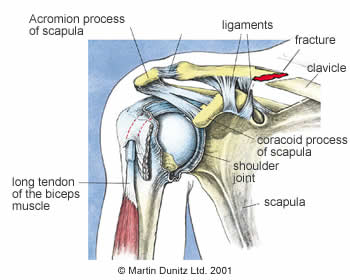| ommon Signs & Symptoms | |||||
| Pain | Swelling | Stiffness | Weakness | Instability | Locking |
Broken Collar Bone Explained
A broken Collar bone (broken Clavicle) is a very common shoulder injury. A broken collar bone frequently occurs when someone falls onto an out stretched hand. For cyclists, it is a very common injury when falling from their bike. The Collar bone (Clavicle) is attached centrally to the sternum (breast bone) and at its outer side to the shoulder complex. This arrangement means that when a person falls onto an outstretched hand, the force is transmitted up the arm resulting in a collar bone fracture. Sometimes a direct blow to the clavicle can also result in a broken Collar bone.

With broken Collar bones in children, there is usually little displacement of the two fracture fragments and subsequent healing occurs quickly over a period of 2 to 3 weeks. In older individuals, where more force is applied to produce a broken Collar bone, the two fragments often become displaced and are prominent through the skin. Once the fractured bone has been reduced back into place by the treating doctor it will usually heal in about 6 weeks.
Occasionally there are complications with this type of fracture, including a fragment of bone causing damage to blood vessels in the chest, or imperfect union of the two fracture fragments which leads to a prominent notch once
Broken Collar Bone Signs & Symptoms
Because the Collar bone is so close to the surface of the skin, the fracture is usually characterised by the protruding fracture fragments. As with any fracture there is considerable pain, and bruising may be visible. The patient will hold the arm immobile in an attempt to relieve the pain.
Broken Collar Bone Treatment
Treatment of a broken Collar bone is dependent upon the degree of displacement of the fracture fragments. If the two pieces of bone are reasonably well aligned, it will usually be sufficient to immobilise the affected arm in a sling or a figure-of-eight harness.
Where there is excessive displacement that prevents fracture union and healing, the orthopaedic consultant may choose to repair the fracture surgically using screws. However, this situation is rare as the Clavicle has a very good capacity to heal.
What you can do
| Consult a sports injury expert | |
| Practice exercises to maintain range of movement | |
| Maintain forearm & grip strength with hand therapy exercises | |
| Use resistance bands for shoulder strengthening exercises | |
| Wear a shoulder support for reassurance |
Throughout the healing process the patient should follow a series of exercises to maintain the range of movement in the elbow, wrist and hand of the affected limb. Hand Therapy Balls and Therapeutic Putty are particularly helpful to maintain forearm and grip strength.
After a few weeks shoulder range of movement exercises can be progressed to gradually increase available shoulder movement. These exercises may be a little uncomfortable, but with some encouragement from a Chartered Physiotherapist this discomfort should quickly resolve as normal movement returns. Shoulder strengthening should then begin using Resistance Bands to regain full function. Resistance bands are ideal for shoulder rehabilitation as they allow multi-planar movements and rotations to be strengthened, critical for a return to normal function.
Once full range of movement and shoulder strength has been achieved, unrestricted shoulder motion is permitted. A return to sport should be granted by the orthopaedic consultant, based on functional ability and x-ray evidence. Many people find that a Neoprene Shoulder Support is helpful following a Collar bone fracture to provide protection and peace of mind when returning to activity.
Broken Collar Bone Prevention
Because of the traumatic nature of a broken Collar bone, prevention strategies are limited. Care should be taken to avoid falls onto an outstretched arm, especially where weather conditions make the surface extra slippery.


